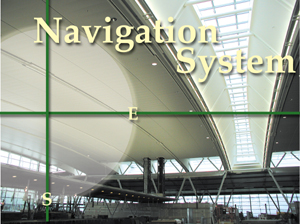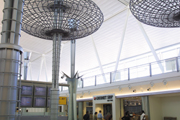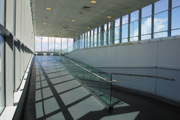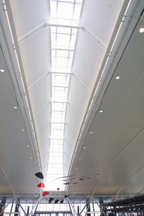

With special consideration to the city's role in the world of yesterday and today, the fourth floor of John F. Kennedy Airport's Terminal 4 not only received a facelift, but also a new feel.
"We were trying to replace a building that was installed in the '50s with a new building that had the image that was appropriate to the world-class city that New York is," says Tony Vacchione, partner at Skidmore, Owings & Merrill, the New York architectural firm that designed the terminal. "Every element of the design was to contribute to the idea of creating a gateway that was a clear, understandable light-filled facility."
The terminal intuitively eases passengers through the ticketing process, leading their eyes straight to the ticketing counter from the front door. Stepping away from the counters, passengers clearly see gates to the left and right and, ultimately, the airfield. This design gives a special nod to the city's melting-pot culture.
"Many of the passengers coming through this terminal don't necessarily speak English as their first language or speak any English at all," explains Vacchione. "The design of each element was to make the way-finding clear and natural, so that a minimum of signs were required in order to guide the passenger to the appropriate gate."
One of the key elements in the navigational scheme is the ceiling. The series of large, arching curves and skylights takes one's eyes from the curb all the way to the airfield, reinforcing the direction of movement. A system of metal perforated panels, the white ceiling also makes the room feel warmer and brighter while dampening the sound, Vacchione says.

Up, up and away
The ceiling system was by Simplex Inc., of Montreal. Known for 20 years as Layaway, Simplex modified the product for the JFK terminal and renamed it Hookaway, based on the installation process, or Generation 2000, also known as G2000. G2000 is used with an aluminum C-channel extrusion suitable for accommodating the customized 2-foot-by-10-foot panels, as opposed to a weaker and smaller rolled Z-bar system with which the 2-foot-by-4-foot Layaway is installed."We had a choice of suppliers and we chose Simplex," says Richard Lee, vice president of Nastasi Associates of Garden City Park, N.Y., the ceiling contractor, citing teamwork and flexibility as critical factors in the specification. "They were willing to work with us because it was a custom system. We ran into every problem you could run into with ceilings, and this ceiling adapted itself to it."
Necessitating a custom system was the movement of the terminal building, which was made of steel. Normally, ceilings' perimeters are attached to the walls, but an up-and-down flexibility of the roof to account for snow and contractions of the steel building itself meant the system would have to "float," independent of the walls and the 300-foot trusses.
"For that we thought of using an extrusion that attaches directly to the primary suspension, the black iron," explains Simplex's designer and project manager Gaetano D'Agata. "By doing this, we didn't have a need to attach the ceiling to the wall or to the side structure.
Nastasi surveyed the existing steel conditions and plotted out the many radii through a CAD system. From there, Nastasi and Simplex came up with special anchors that went through the metal sheathing on the roof, to which the contractor's crew of about 100 hooked the 500,000 square feet of ceiling.
"From the black iron to the ceiling grid system Simplex came up with a new type of clamp fastener that makes a rigid tie," says Lee, adding that the system meets all building codes. "That's what gives the ceiling its flexibility. It's a very good idea."
To ensure positive alignment in all directions of the panels, two aligning pins and a lipping clip were added to interlock them. According to D'Agata, this new method of aligning the panels facilitates and improves the installation of large panels, as well as the appearance of the ceiling system.
In addition to the design demands, the ceiling also had to meet acoustical ratings. To dampen sound and eliminate possible vibration and resulting noise due to the curved suspension, a piece of urethane was placed between each panel in the suspension.

No layover
Coordinating installation of the ceiling proved a challenge with only 16 months to complete the entire building."In order to meet the schedule demands, we had to find a way to work on the ceiling, flooring and checking counters simultaneously," says John Babieracki, executive vice president for AMEC, of New York, the general contractor for the project.
He says the company devised a rolling scaffold system 90 feet wide by more than 200 feet long. All the trades used the scaffold system for a scheduled designated time frame, and then all the trades moved at once, in an easterly to westerly direction. All the while, work went on below the scaffold.
Lee agrees the schedule was tight. Work was completed down to the minute for the May 2001 grand opening. His crew moved out at 6 a.m. and festivities, including the arrival of the governor, began at 6:30.
While the ceiling project required plenty of expertise, Babieracki says it took more for Nastasi to be awarded the contract.
"We analyzed resources, numbers of men and experience of team in doing a series of projects," he says. "It was not just a low-bid scenario. We try to get the lowest, most responsible bid to do the project and they turned out to be the one on that job."
In completing the project, Lee credits his company's flexibility in combination with the ceiling manufacturer and architect.
"Because it's a brand new system it took a lot of going back and forth to be sure everything worked," he says. "And we were satisfied with the system when it was done."
